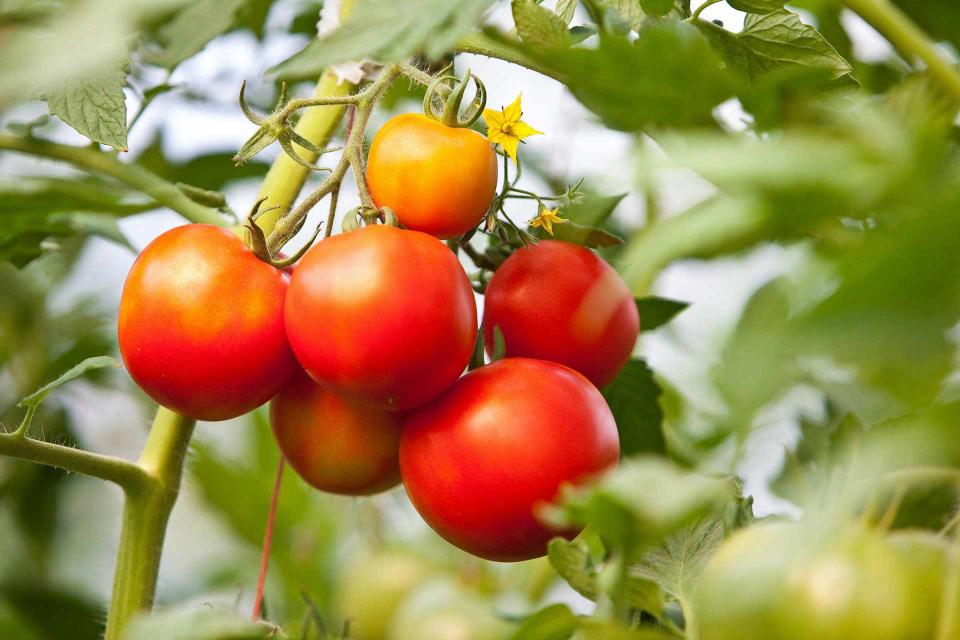11 Common Mistakes That Are Hurting Your Tomato Plants—and How to Avoid Them
Ensure a delicious and bountiful harvest by avoiding these common pitfalls.

Tomatoes are a delicious and versatile fruit that will make a great addition to your summer garden. But they can sometimes be difficult to maintain and are susceptible to a few common issues, including blossom-end rot, split skins, and sunscald. To ensure a bountiful harvest every season, experts say to avoid making these mistakes when growing tomatoes.
Meet the Expert
Carrie Spoonemore, co-creator of Park Seed's From Seed to Spoon app, an app that makes garden planning easier.
Levi Gardner, an ecological food and farming system expert and former director of Urban Roots, a non-profit community farm, market, and education center.
Related: Your Guide to Growing Tomato Plants From Seeds
Planting Too Soon
Avoid the urge to plant tomatoes too early in the season. "Planting tomatoes too early risks exposing them to frost or cold temperatures, which can stunt their growth or kill the seedlings," says Carrie Spoonemore, co-creator of Park Seed's From Seed to Spoon app. "It's important to refrain from planting until the soil has sufficiently warmed and the threat of frost has passed."
Planting Too Late
On the other hand, you should also avoid planting tomatoes too late in the season. "Tomatoes need warm weather to grow and mature," says Spoonemore. "If you plant tomatoes too late in the season, there might not be enough time for them to mature and produce fruit before the colder weather arrives."
Not Hardening Off Seedlings
If you started tomato seeds indoors, it's important to harden them off before planting them outside. "Because the plants have likely been in a controlled environment all their lives, they need to slowly be introduced to the outdoor elements—giving them the opportunity to adapt to the stresses of wind, rain, and variable temperatures," says Levi Gardner, co-executive director of Urban Roots.
The hardening process takes one to two weeks. Start by leaving your tomato plant outside for one hour on its first day, two on its second day, and so forth, until the plant has adjusted without sunscald, says Gardner.
Not Planting Deep Enough
Tomatoes do best when they're planted deeply in the soil. "Shallow planting can be a mistake as tomato plants need to have their root system buried deep in the soil for stability and proper nutrient uptake," says Spoonemore. "Tomatoes should be planted deep enough so that a significant portion of the stem is buried. This encourages the development of additional roots, which strengthens the plant." Plant tomato seedlings so the first set of leaves is just above the soil level.
Watering Inconsistently
Keep the soil consistently moist when watering your tomato plants. "Inconsistent watering can result in uneven soil moisture levels, which may lead to blossom end rot, fruit cracking, or other physiological disorders," says Spoonemore. "Tomato plants generally require consistent moisture, and they should be watered deeply whenever the soil feels dry to the touch."
Related: Experts Explain Why Tomatoes Split, Plus Tips for Prevention
Not Staking
Not staking tomato plants can result in sprawling growth and increased susceptibility to disease. "Staking provides support for the plants and helps keep them upright, improving air circulation and reducing the risk of fungal infections," says Spoonemore.
Planting Seedlings Too Close Together
Avoid planting tomato seedlings too close together, which can lead to overcrowding, competition for nutrients, and increased risk of disease. "It's recommended to space tomato seedlings about 18 to 24 inches apart, in rows that are 3 to 4 feet apart to allow for proper air circulation and growth," says Spoonemore. "Tomato seeds should be spaced 2 to 3 inches apart. Once they sprout, you can thin them out to one seedling every 18 to 36 inches.
Not Harvesting When Ready
Not harvesting ripe tomatoes when they're ready can lead to over-ripening, splitting, and rotting, which can attract pests and diseases. "Harvesting tomatoes when they reach their optimal ripeness is essential to ensure the best flavor and quality and maintain a healthy garden," says Spoonemore.
Related: The Best Companion Plants for Tomatoes, Plus Tips to Make Sure Yours Thrive
Not Companion Planting
Companion planting encourages healthy tomato plants by attracting beneficial insects, repelling pests, and improving soil fertility. "Failing to companion plant may result in missed opportunities to enhance the health and productivity of tomato plants naturally and an increased risk of pests and diseases," says Spoonemore.
Forgetting to Prune Your Plants
Most indeterminate tomatoes benefit greatly from pruning and can even produce more and bigger fruit, says Gardner. As tomato plants grow, they produce a lot of new shoots—called suckers—that, if left unpruned, can lead to a disproportionate number of stems without fruit. "If you don't manage these new shoots, you may end up with a whole plant of just suckers with no fruit to show," he says. "Pruning can ensure there is a good proportion of vegetative and reproductive growth—leaf to fruit ratio—and the plant is photosynthesizing at its best."
Choosing the Wrong Pest Control
All organic pesticides aren't created equal. Gardner recommends using organic products that have "OMRI"—which stands for Organic Materials Review Institute—on the label. Additionally, you should add a concentrated, organic neem oil to your pesticide routine. "Tomatoes are highly susceptible to blight and tomato hornworm," says Gardner. "This organic spray helps to deter—but not kill—those pests."
Read the original article on Martha Stewart.

